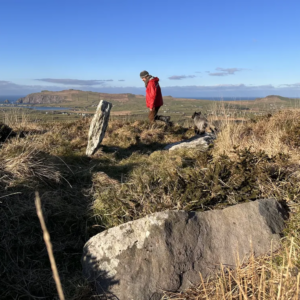Billy Mag Fhloinn located the Altóir na Gréine, thought to have vanished in the 19th century, in southwest Ireland
:focal(1087x787:1088x788)/https://tf-cmsv2-smithsonianmag-media.s3.amazonaws.com/filer_public/92/73/92735a5b-5d53-4fae-9928-86d99e3f50b5/screen_shot_2024-01-19_at_142049_4.png) Archaeologist and folklorist Billy Mag Fhloinn rediscovered the Altóir na Gréine, or the “Altar of the Sun,” in Ireland. Seán Mac an tSíthigh
Archaeologist and folklorist Billy Mag Fhloinn rediscovered the Altóir na Gréine, or the “Altar of the Sun,” in Ireland. Seán Mac an tSíthigh
A 4,000-year-old tomb has been rediscovered in Ireland—more than 170 years after it was thought to have been destroyed.
The tomb is called Altóir na Gréine, which means the “Altar of the Sun” in Irish. In 1838, an English aristocrat named Georgiana Chatterton visited and sketched the site, writing in her travel journal that she’d found “a curious piece of antiquity once an altar, supposed to have been used for offering sacrifices to the sun,” according to Seán Mac an tSíthigh of RTÉ News, which first reported the story.
In 1852, however, the antiquarian Richard Hitchcock visited the site and concluded that the tomb had been dismantled, perhaps so that its stones could be reused elsewhere. Since then, researchers assumed that Altóir na Gréine was no more.
But Billy Mag Fhloinn, an Irish archaeologist and folklorist at Sacred Heart University, wondered if the tomb’s remains still existed.
“I was just struck by the mystery of this thing being missing—and, in a way, the drama of the location itself along the ridge of that hill,” Mag Fhloinn tells McClatchy’s Moira Ritter. “It was something that I just wanted to tie together. I just felt like there’s an unanswered question here.”
He started building a photogrammetric model using images he’d taken of the site, which is located near his home in southwest Ireland. A few months ago, the researcher spotted a stone that reminded him of Chatterton’s sketch.
Mag Fhloinn contacted Ireland’s National Monuments Service, which sent in archaeologist Caimin O’Brien. Upon closer inspection, they confirmed they’d located the long-lost Altóir na Gréine.
Getting there, however, took a bit of creative maneuvering.
“The way I found it was by climbing over barbed-wire fences, but not everybody wants to do that,” Mag Fhloinn tells Live Science’s Tom Metcalfe.
He adds that only one of the tomb’s ancient stones was still standing, but several others appear to be buried below the soil. He doesn’t expect to find human remains at the site, as the wet soil surrounding the tomb would have likely hastened the erosion of any bones.
The tomb is located on top of a hill near Ballyferriter, a small village on the Dingle Peninsula. Archaeologists say it’s a wedge tomb, a common burial structure in the region formed by situating large, upright stones in a rectangle and then placing a large capstone on top. This particular example likely dates to between 2500 B.C.E. and 2000 B.C.E.
Many questions remain about the site. For instance, what happened to it in the 1800s is still unclear.
“In the 19th century, there was quite a taboo about the destruction of these sites—it was said it would bring bad luck or disaster,” Mag Fhloinn tells the Guardian’s Rory Carroll.
The tomb’s name is also intriguing. The “Altar of the Sun” moniker hints at the possibility that the tomb was built in “an alignment originally with the rising sun on some particular day,” Mag Fhloinn tells McClatchy.
“There’s a sort of complex set of possibilities of how it might become associated with the sun,” he says.
The site will now be listed in the country’s national monuments database. O’Brien tells RTÉ News that the find’s significance lies in its addition to the archaeological record, which will aid future research.
He says: “For the first time in over 180 years, archaeologists know where the tomb is situated—and it will enhance our understanding of wedge-tomb distribution.”
